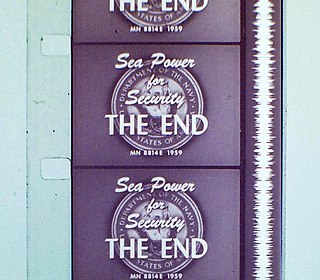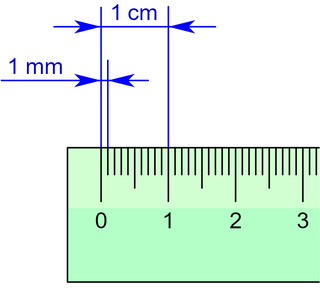
A narrow-gauge railway is a railway with a track gauge narrower than 1,435 mmstandard gauge. Most narrow-gauge railways are between 600 mm and 1,067 mm.

A standard-gauge railway is a railway with a track gauge of 1,435 mm. The standard gauge is also called Stephenson gauge, international gauge, UIC gauge, uniform gauge, normal gauge in Europe, and SGR in East Africa. It is the most widely used track gauge around the world, with about 55% of the lines in the world using it.

16 mm film is a historically popular and economical gauge of film. 16 mm refers to the width of the film ; other common film gauges include 8 mm and 35 mm. It is generally used for non-theatrical film-making, or for low-budget motion pictures. It also existed as a popular amateur or home movie-making format for several decades, alongside 8 mm film and later Super 8 film. Eastman Kodak released the first 16 mm "outfit" in 1923, consisting of a camera, projector, tripod, screen and splicer, for US$335. RCA-Victor introduced a 16 mm sound movie projector in 1932, and developed an optical sound-on-film 16 mm camera, released in 1935.

The M4 Sherman, officially medium tank, M4, was the medium tank most widely used by the United States and Western Allies in World War II. The M4 Sherman proved to be reliable, relatively cheap to produce, and available in great numbers. It was also the basis of several other armored fighting vehicles including self-propelled artillery, tank destroyers, and armored recovery vehicles. Tens of thousands were distributed through the Lend-Lease program to the British Commonwealth, Soviet Union, and other Allied Nations. The tank was named by the British after the American Civil War General William Tecumseh Sherman.

The millimetre or millimeter is a unit of length in the International System of Units (SI), equal to one thousandth of a metre, which is the SI base unit of length. Therefore, there are one thousand millimetres in a metre. There are ten millimetres in a centimetre.

Anti-aircraft warfare is the counter to aerial warfare and includes "all measures designed to nullify or reduce the effectiveness of hostile air action". It encompasses surface-based, subsurface (submarine-launched), and air-based weapon systems, in addition to associated sensor systems, command and control arrangements, and passive measures. It may be used to protect naval, ground, and air forces in any location. However, for most countries, the main effort has tended to be homeland defence. Missile defence is an extension of air defence, as are initiatives to adapt air defence to the task of intercepting any projectile in flight.

Paper size standards govern the size of sheets of paper used as writing paper, stationery, cards, and for some printed documents.

135 film, more popularly referred to as 35 mm film or 35 mm, is a format of photographic film with a film gauge of 35 mm (1.4 in) loaded into a standardized type of magazine for use in 135 film cameras.

In guns, particularly firearms, but not artillery, where a different definition may apply, caliber is the specified nominal internal diameter of the gun barrel bore – regardless of how or where the bore is measured and whether the finished bore matches that specification. It is measured in inches or in millimeters. In the United States it is expressed in hundredths of an inch; in the United Kingdom in thousandths; and elsewhere in millimeters. For example, a US "45 caliber" firearm has a barrel diameter of roughly 0.45 inches (11.43mm). Barrel diameters can also be expressed using metric dimensions. For example, a "9 mm pistol" has a barrel diameter of about 9 millimeters. Since metric and US customary units do not convert evenly at this scale, metric conversions of caliber measured in decimal inches are typically approximations of the precise specifications in non-metric units, and vice versa.

The following are examples of orders of magnitude for different lengths.

In rail transport, track gauge is the distance between the two rails of a railway track. All vehicles on a rail network must have wheelsets that are compatible with the track gauge. Since many different track gauges exist worldwide, gauge differences often present a barrier to wider operation on railway networks.

The Florida Keys are a coral cay archipelago off the southern coast of Florida, forming the southernmost part of the continental United States. They begin at the southeastern coast of the Florida peninsula, about 15 miles (24 km) south of Miami and extend in a gentle arc south-southwest and then westward to Key West, the westernmost of the inhabited islands, and on to the uninhabited Dry Tortugas. The islands lie along the Florida Straits, dividing the Atlantic Ocean to the east from the Gulf of Mexico to the northwest, and defining one edge of Florida Bay. The southern part of Key West is 93 miles (150 km) from Cuba. The Keys are located between about 24.3 and 25.5 degrees North latitude.

A mortar today is usually a simple, lightweight, man-portable, muzzle-loaded cannon, consisting of a smooth-bore metal tube fixed to a base plate with a lightweight bipod mount and a sight. Mortars are typically used as indirect fire weapons for close fire support with a variety of ammunition. Historically mortars were heavy siege artillery. Mortars launch explosive shells in high-arching ballistic trajectories.

The Bofors 40 mm Automatic Gun L/60 is an anti-aircraft autocannon, designed in the 1930s by the Swedish arms manufacturer AB Bofors. The gun was designed as an intermediate anti-aircraft gun, filling the gap between fast firing close-range small calibre anti-aircraft guns and slower firing long-range high calibre anti-aircraft guns. For its time, the Bofors 40 mm L/60 was perfectly suited for this role and outperformed competing designs in the years leading up to World War II in both effectiveness and reliability.

A tankōbon is a standard publishing format for books in Japan, alongside other formats such as shinsho and bunkobon. Used as a loanword in English, the term specifically refers to a printed collection of a manga that was previously published in a serialized format. Manga tankōbon typically contain a handful of chapters, and may collect multiple volumes as a series continues publication.

The Fiat Ducato is a light commercial vehicle jointly developed by FCA Italy and PSA Group, and mainly manufactured by Sevel, a joint venture between the two companies since 1981. It has also been sold as the Citroën C25, Peugeot J5, Alfa Romeo AR6 and Talbot Express and later as the Fiat Ducato, Citroën Jumper, and Peugeot Boxer, from 1994 onwards. It entered the North American market as the Ram ProMaster in May 2014 for the 2015 model year.

The gauge of a firearm is a unit of measurement used to express the inner diameter of the barrel.

The Chrysler Hemi engine, known by the trademark Hemi or HEMI, refers to a series of high-performance American overhead valve V8 engines built by Chrysler with hemispherical combustion chambers. Three generations have been produced: the FirePower series from 1951 to 1958; a famed 426 cu in (7.0 L) race and street engine from 1964-1971; and family of advanced Hemis (displacing between 5.7 L 6.4 L from 2003 to 2024.
The aspect ratio of an image is the ratio of its width to its height. It is expressed as two numbers separated by a colon, width:height. Common aspect ratios are 1.85:1 and 2.40:1 in cinematography, 4:3 and 16:9 in television, and 3:2 in still photography.















